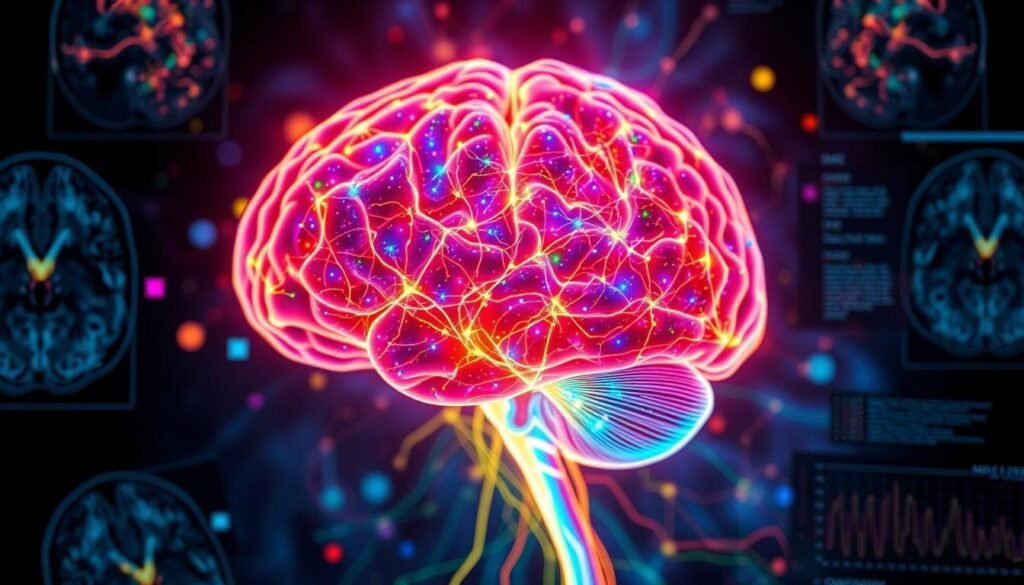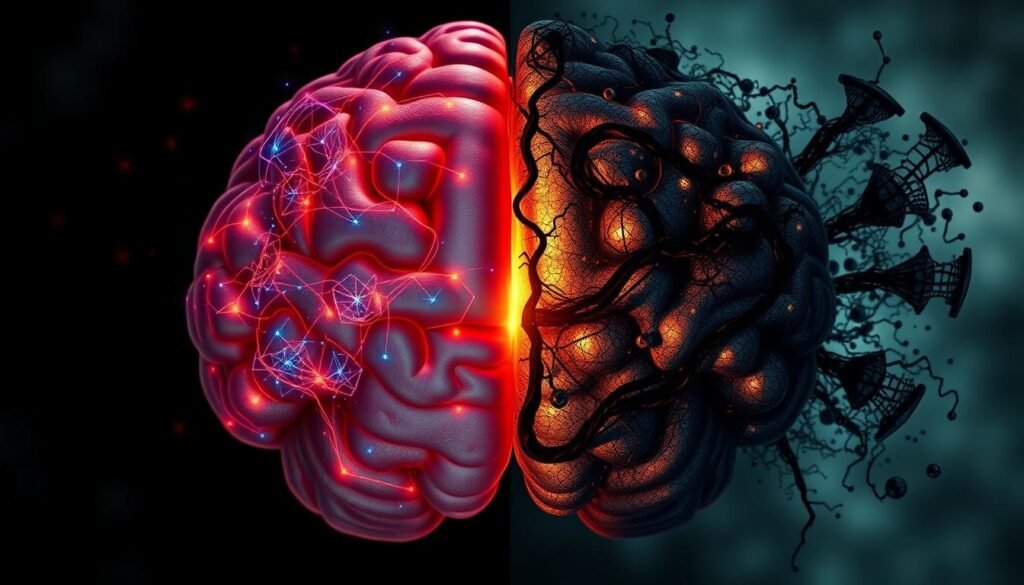Is how we feel controlled by our brain’s structure? This study looks into Major Depressive Disorder (MDD) and its link with brain changes. It affects over 300 million people globally. With MRI scans, scientists found brain irregularities in people with MDD. These findings could lead to better treatments. This research highlights how understanding MDD’s brain basis is key. It also shows recovery’s connection to neuroplasticity, the brain’s ability to change.
Key Takeaways
- Major Depressive Disorder affects approximately 16.2% of the global population.
- Over 30% of patients experience ineffective treatment outcomes with antidepressants.
- Structural changes in key brain areas are common among MDD patients.
- Neuroplasticity plays a crucial role in mood regulation and recovery.
- Emerging research highlights the importance of neuroimaging in understanding depression.
Understanding Major Depressive Disorder
Major Depressive Disorder (MDD) is a serious mental condition. People with MDD feel very sad and lose interest in life. These issues go beyond simple sadness, affecting how a person thinks, feels, and manages daily life.
Definition and Symptoms
Depression shows up differently in everyone. Common signs include lasting sadness, tiredness, getting annoyed easily, and trouble focusing. MDD can also lead to sleeping too much or too little, and sudden weight changes. Spotting these signs early helps with getting the needed help.
Prevalence and Impact
Depression is quite common, impacting over 300 million worldwide. In the U.S., about 16.2% of adults will face MDD at some point. It lessens life quality and raises healthcare costs and time off work. Certain groups like pregnant women, older adults, and kids are more at risk.
We must address depression’s societal effects. It heavily influences cognitive abilities and can get worse if left untreated. To learn more about how depression affects the brain, click here.
| Aspect | Details |
|---|---|
| Global Prevalence | Over 300 million people |
| Lifetime Prevalence in the U.S. | Approximately 16.2% |
| High-Risk Groups | Pregnant women, elderly, children |
| Gender Disparity | Women are twice as likely to be affected |
| Potential Future Burden | Ranked as the third most burdensome disease by WHO, projected to be the leading cause by 2030 |
Neurobiological Foundations of Depression
Looking into depression means studying how parts of the brain talk to each other. This includes areas that control feelings, thoughts, and emotions. Research shows that changes in the brain play a big part in mood disorders. These changes affect how the brain works and lead to feelings of sadness.
Overview of Brain Function in Mood Disorders
Experts have found that depression messes up certain brain circuits. This affects the frontal lobes, hippocampus, and amygdala. They’re important for managing emotions and memories. When these parts don’t work right, it can make decision-making hard and increase negative feelings.
Importance of Neuroimaging Studies
Neuroimaging helps us learn more about depression’s impact on the brain. Tools like fMRI and DTI let researchers see changes in how the brain is connected and structured. They’ve found that people with depression have differences in brain size and function. This supports how physical changes in the brain link to the symptoms of mood disorders.

| Brain Region | Function | Impact of MDD |
|---|---|---|
| Frontal Lobes | Decision-making, impulse control | Reduced activity, leading to poor decision-making |
| Hippocampus | Memory formation, emotion regulation | Volume reduction, impairing memory and emotional responses |
| Amygdala | Processing emotions, particularly fear and pleasure | Enhanced activity, resulting in heightened anxiety and emotional distress |
Major Depressive Disorder and Brain Changes
It’s vital to understand how major depressive disorder (MDD) and brain changes connect. MDD leads to big changes in certain brain areas. These changes can deeply affect how we control mood and emotions.
Structural Alterations in Key Brain Regions
Studies have found structural alterations in depression across different brain regions. A big review of 320 studies with over 21,000 people found that people with MDD had smaller frontal cortex and hippocampus areas. This reduction is linked to ongoing symptoms, showing us how MDD changes the brain.
Changes in the amygdala are also significant. The amygdala helps us process emotions and experience sadness or fear.
Functional Connectivity Differences
The functional connectivity in depression is key to understanding MDD. People with MDD show weaker connections in important brain networks. This includes the default mode network and salience network.
Studies show that people with MDD often have less coordinated brain activity. They also have higher activity in certain brain networks. This lack of coordination is linked to how severe the symptoms are. In comparison, healthy people show strong connections across their brain networks.

To fully grasp this, looking into more neuroimaging studies on brain changes helps. Knowing these patterns is crucial for creating better treatments and finding MDD early in people.
Neuroplasticity in Major Depressive Disorder
Neuroplasticity helps us understand major depressive disorder (MDD) and its effects on mood. The brain’s ability to change and adapt affects emotional strength. Positive activities like psychotherapy and taking medicine help the brain change, aiding recovery from depression.
Yet, long-term stress and lasting depression effects can slow down new nerve cell growth. This is true especially in the hippocampus. This makes getting better harder and can make symptoms worse.
The Role of Neuroplasticity in Mood Regulation
Neuroplasticity in depression impacts emotional wellness and recovery. Making neuroplastic changes can help balance brain chemistry for better mood control. Activities like regular exercise and mindfulness, including meditation, promote new nerve cell growth. They improve feelings.
These activities also increase brain-derived neurotrophic factor (BDNF), which helps the brain work better. This not only brings physical benefits but also boosts emotional resilience.
Effects of Neuroplastic Changes on Recovery
Changes in the brain’s plasticity play a key role in recovering from major depressive disorder. Studies show that treatments like repetitive transcranial magnetic stimulation (rTMS) can enlarge the hippocampus. This growth links to better memory and clearer thinking. It offers hope for those with hard-to-treat depression.
Combining brain stimulation with traditional treatments, like SSRIs, shows how powerful neuroplasticity can be. It highlights its potential to fight depression symptoms.

Hippocampus Atrophy and Its Implications
Hippocampus atrophy is a key sign in people with Major Depressive Disorder (MDD). It affects memory and emotions deeply. Studies show that it leads to problems with memory and controlling emotions in depression.
Impact on Memory and Emotion Regulation
Hippocampus atrophy harms thinking skills. Those with MDD may struggle with remembering and feelings. A smaller hippocampus means they can’t manage emotions well. This makes negative feelings last longer and makes depression harder to handle.
Research Findings on Hippocampus Volume
A big study with 636 people found early and late depression affect the hippocampus differently. Early depression leads to a smaller hippocampus. This shows the link between how long and severe depression is and hippocampus shrinkage. However, people with late depression had normal hippocampus sizes but smaller entorhinal cortex volumes.
The same study found major depression can shrink the hippocampus by 8% to 19%. These numbers show the strong link between hippocampal health, memory function, and emotion control in depression.
Amygdala Hyperactivity in Depression
The amygdala plays a key role in handling emotions, especially the negative ones. It’s often more active in those with Major Depressive Disorder (MDD). This increased activity makes them more sensitive to negative things and makes it hard to handle emotions. Knowing about this can help find better treatments.
Connection to Negative Emotion Processing
Studies show that teens with MDD have a more active left amygdala. This means they react more to emotional signals. A study with 24 teens, half with MDD, showed this difference clearly. This overactivity links closely to processing negative emotions. It sheds light on how these reactions shape depression.
Potential Treatment Implications
Focusing on amygdala hyperactivity opens new paths for treating MDD. Reducing amygdala activity might help ease depression symptoms. Using therapy and medicine can be key in finding balance and better emotional health. To learn more, explore how depression affects the brain and body
Prefrontal Cortex Dysfunction in MDD
The prefrontal cortex plays a key role in Major Depressive Disorder (MDD). This brain area greatly affects decision-making in depression and emotional control in MDD. Studies show that MDD patients often have lower activity in the PFC during cognitive tasks. This can lead to symptoms like trouble making decisions and emotional instability.
Influence on Decision-Making and Emotional Control
Changes in the prefrontal cortex can impact important decision-making processes. People with MDD may have a hard time with cognitive flexibility. This is vital for solving problems and adapting to changes. Therapy that focuses on prefrontal cortex dysfunction could help patients manage their emotions better and make decisions more effectively. Improving PFC function shows promise in developing ways to better control emotions and help individuals handle their feelings more effectively.
Variations in Activity Levels During Tasks
Research finds clear changes in the prefrontal cortex’s activity during tasks in those with emotional distress. This issue often ties back to weaker responses to positive stimuli, making it hard for them to interact positively with their surroundings. Understanding these activity changes helps us learn about the biological aspects of MDD. For more detailed insights, you can read a comprehensive review here.
Differences in brain responses highlight the complexity of MDD. This means research must continue to improve treatment methods. Studying the PFC’s role in MDD is essential for creating targeted interventions. These interventions can help patients improve both their thinking and emotional management. They help patients feel more in control of their lives.
Neurotransmitter Imbalance and Brain Inflammation
Understanding how neurotransmitter balance and inflammation link is key in tackling Major Depressive Disorder (MDD). Neurotransmitters like serotonin, norepinephrine, and dopamine are vital for good brain function. When their levels are off, it greatly impacts the symptoms and severity of MDD.
Common Neurotransmitters Involved in Depression
Serotonin’s role in managing our mood is crucial. Low serotonin is tied to sadness and despair. Norepinephrine is about alertness and energy. Its lack can make one feel like they’re in a ‘fog’ during depression. Dopamine, the “feel-good” chemical, drives motivation and pleasure. An imbalance here can stir up serious emotional issues.
Research on Inflammation in the Brain
Recent studies show inflammation’s big role in MDD. People with depression often have higher inflammatory markers, like CRP and TNF-α, than those without it. This points to brain inflammation worsening neurotransmitter imbalances, adding to treatment challenges. Chronic inflammation has also been connected to depressive symptoms. This underlines the importance of a comprehensive strategy in battling MDD.
Conclusion
Research shows a complex link between mental health issues like Major Depressive Disorder (MDD) and changes in the brain. Studies reveal that over 300 million people globally suffer due to these brain changes. Structural MRI and diffusion tensor imaging show big shifts in brain structure and how it connects.
Understanding the brain’s role helps us see how hard it is for people with MDD. Sadly, more than 30% don’t find relief with current antidepressants. This highlights a big need for treatments that go after these specific brain changes.
To better fight depression, we must keep up with research on how the brain alters. Tailoring treatment plans to the unique brain changes can help improve lives. Our aim is to better understand and create effective treatments to help those living with MDD.